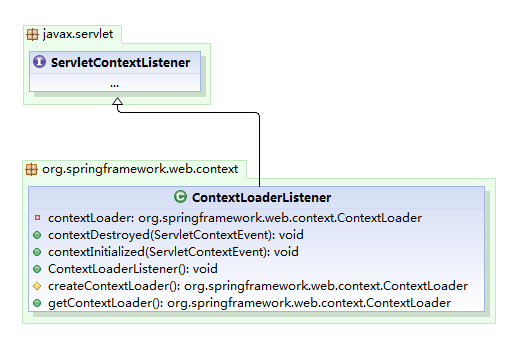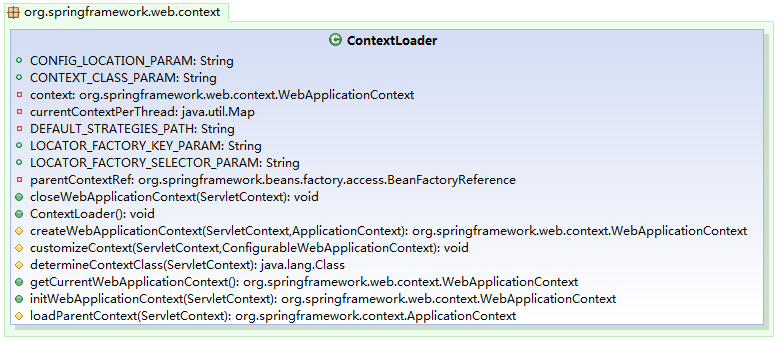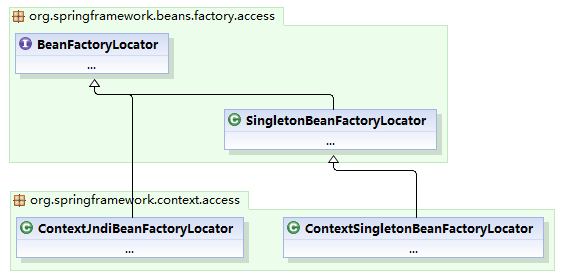一般的Web项目都会在web.xml中加入Spring监听器,内容如下:
我们的问题是,Spring是何时以及如何加载我们的配置文件来初始化Bean工厂的,带着这些问题,我们展开研究:
我们先来看看web.xml中配置的监听器的类,来回答我们的问题,Spring是何时来加载我们的配置文件的:
org.springframework.web.context.ContextLoaderListener

它继承了javax.servlet.ServletContextListener接口。
ServletContextListener是J2EE Servlet API中的一个标准接口,
它能够监听ServletContext对象的生命周期,实际上就是监听Web应用的生命周期。
当Servlet容器启动或终止Web应用时,会触发ServletContextEvent事件,该事件由ServletContextListener来处理。
这里面有两个方法我们比较感兴趣:
这个方法构造一个默认的ContextLoader,ContextLoader可以理解为Spring上下文的加载器。之所以这样去定义这样一个类,是为了开发人员进行重写此方法来使用一个自定义的Spring上下文的加载器。
这个方法很简单,仅仅只是调用了createContextLoader()构造了ContextLoader,并调用其初始化方法。
由此,我们可以得出结论,Spring是在Web项目启动时,通过ServletContextListener机制,来加载以及初始化Spring上下文的。
下面,我们好好研究一下Spring是如何加载其上下文的:
我们先定位ContextLoader类。

看看此类的initWebApplicationContext()方法(省略了不重要的语句)
其中的有两句比较重要,我们来看看:
这个方法的用途主要是用来解决Spring共享环境的,即,如果我们有多个WAR包部署在同一个服务器上,而且这些WAR都共享某一套业务逻辑层。如何共享一套业务逻辑包配置而不要每个WAR都单独配置,这时我们就可能需要Spring的共享环境了。
现在我们引入BeanFactoryLocator,它是Spring配置文件的一个定位器,Spring官方给它的定义是用来查找,使用和释放一个BeanFactory或其子类的接口。下面我们看看此图:

是根据参数locatorFactorySelector去一个单例工厂中去拿一个对应的BeanFactoryLocator,也即,如果工厂中没有对应于locatorFactorySelector的BeanFactoryLocator对象,那就返回一个新的BeanFactoryLocator实例(这里是ContextSingletonBeanFactoryLocator的实例),否则,就从工厂里取现有的BeanFactoryLocator对象。
ContextSingletonBeanFactoryLocator里维护了一个静态的Map对象instances,每次需要新增BeanFactoryLocator实例时都会更新这个Map对象,这个Map对象是以配置文件名为KEY,BeanFactoryLocator对象为值。原因很简单,就是希望同一个配置文件只被初始化一次。
如果没有在web.xml中定义locatorFactorySelector这个参数,父环境的配置文件默认使用:"classpath*:beanRefContext.xml"
此方法定义在SingletonBeanFactoryLocator类中,同样是一个单例工厂模式,判断传入的参数parentContextKey对应的BeanFactory是否有被初始化,经过上面的ContextSingletonBeanFactoryLocator.getInstance(locatorFactorySelector)指定Spring父环境配置文件,这个方法判断指定的父环境是否被初始化,如果有则返回,没有就进行初始化。看看此方法的实现:
此方法分为两作了两件事,
第一,初始化上下文,主意这里初始化的是从web.xml配置参数里的Spring配置文件,也是上面讲loadParentContext方法里的
这句指定的参数。这里初始化的是这个配置文件所有Bean。我们指定的factoryKey对应的Bean也是其中之一。
第二,从已经初始化的Spring上下文环境中获取Spring父环境。
这个一个典型的构造父环境的配置,web项目在启动的时候就会发现里面有Spring父环境的配置,那么Spring首先就会生成一个对应的配置文件为beanRefFactory.xml的BeanFactory(web.xml中的locatorFactorySelector参数指定),同时Spring在解析的时候,会发现factoryBeanId的配置同样为BeanFacotry(beanRefFactory.xml中factoryBeanId对应的Bean),所以Spring在拿父环境时就会写成:
方法实现里引入了BeanFactoryGroup类。类的结构很简单

refCount:用来记录实例被外部引用的记数,当调用locator.useBeanFactory(parentContextKey)方法时,引用数就会加1,当调用CountingBeanFactoryReference#release方法时,引用数就会减1,当它变成0时,Spring就会释放掉它占用的内存,同时也会销毁掉它definition变量引用的BeanFactory。下次再调用locator.useBeanFactory(parentContextKey)就会重新初始化BeanFactory。说到release,请同学们参考ContextLoader中如下的两条语句:
// 在调用CountingBeanFactoryReference#release后,即使对象已经销毁,这个Map仍然可以返回locator对象。
// 如果对象已经销毁,再调用此方法会再一次初始化BeanFactory
bfgInstancesByKey:一个Map对象,以配置文件名为Key,配置文件解析后生成的BeanFactory构成的BeanFactoryGroup为值。
bfgInstancesByObj:一个Map对象,以BeanFactoryGroup.definitiion为Key,以BeanFactoryGroup为值。这个对象主要还是在CountingBeanFactoryReference#release时使用。
下面,我看再看看另一个地方:
上面这句仅仅是做了如下工作:
而我们使用工厂模式的时候,一般是把对象初始化好了,再给外部使用,为什么Spring这里要多此一举,在调用getInstance这后还要去调用useBeanFactory来初始化父环境?为什么Spring开发者不写成如下:
本来我认为这个写法是必须的,后来想想也不是,不过这里体现了Spring的灵活设计。如果按排上面的方法进行改造有几点不妥,1,每次都会初始化,开销比较大,可能有需求是需要延迟初始化的。2,每次都需要初始化都需要传入两个参数,分别为:配置文件名与父工厂名,3,类职责混乱,比如一个配置文件中可能定义了多个父环境的Bean,采用Spring这种方法是很清晰的:
而使用我们改造的方法,则要写成如下:
相当麻烦且无语,引用了也只是这个配置文件中的某一个Bean的引用,没什么意义。
这就是为什么BeanFactoryLocator接口存在的一个原因,用于查找某个配置文件中的一个BeanFactory。
我们来看看这个函数做了些什么:
再来看看Spring是如果进行初始化ApplicationContext的。就以XmlWebApplicationContext来说,它继承了ConfigurableWebApplicationContext这个接口,里面有个refresh()方法,我们可以看看它的实现(AbstractApplicationContext):
这个方法的实现由于涉及的东西比较多,比较国际化,事件等等,等我们理解了后续的源代码分析之后再重新过来进行研究。这样效率更高点。
这样关于Spring在web项目中加载及初始化的方式我们大概也了解的比较清楚了,我们可以看到,Spring就第一步,加载都已经做了很多工作,不得不佩服Spring团队的智慧。
最后,Spring加载完成之前,会将ApplicationContext放入ServletContext中,方便程序进行访问。
其中WebApplicationContext.ROOT_WEB_APPLICATION_CONTEXT_ATTRIBUTE定义如下:
Spring环境
加载组件:ContextLoaderListener
配置路径:Servlet环境初始化参数contextConfigLocation指定的路径
缺省路径: 没有缺省路径
Spring环境的父环境
加载组件:ContextLoaderListener和ContextSingletonBeanFactoryLocator
配置路径:Servlet环境初始化参数locatorFactorySelector指定Bean工厂定位器使用的给BeanFactory,Servlet环境初始化参数parentContextKey指定Bean工厂定位器用于查找BeanFactory的关键字
缺省路径: parentContextKey的缺省路径是classpath*:beanRefFactory.xml
这里我们还有一个功能相近的类没有进行说明:
ContextJndiBeanFactoryLocator
有兴趣的同学可以自己看一下。
- <listener>
- <listener-class>org.springframework.web.context.ContextLoaderListener</listener-class>
- </listener>
- <context-param>
- <param-name>contextConfigLocation</param-name>
- <param-value>classpath*:applicationContext-struts.xml,classpath*:spring/applicationContext.xml</param-value>
- </context-param>
我们的问题是,Spring是何时以及如何加载我们的配置文件来初始化Bean工厂的,带着这些问题,我们展开研究:
我们先来看看web.xml中配置的监听器的类,来回答我们的问题,Spring是何时来加载我们的配置文件的:
org.springframework.web.context.ContextLoaderListener

它继承了javax.servlet.ServletContextListener接口。
ServletContextListener是J2EE Servlet API中的一个标准接口,
它能够监听ServletContext对象的生命周期,实际上就是监听Web应用的生命周期。
当Servlet容器启动或终止Web应用时,会触发ServletContextEvent事件,该事件由ServletContextListener来处理。
这里面有两个方法我们比较感兴趣:
- /**
- * Create the ContextLoader to use. Can be overridden in subclasses.
- * @return the new ContextLoader
- */
- protected ContextLoader createContextLoader() {
- return new ContextLoader();
- }
这个方法构造一个默认的ContextLoader,ContextLoader可以理解为Spring上下文的加载器。之所以这样去定义这样一个类,是为了开发人员进行重写此方法来使用一个自定义的Spring上下文的加载器。
- /**
- * Initialize the root web application context.
- */
- public void contextInitialized(ServletContextEvent event) {
- this.contextLoader = createContextLoader();
- this.contextLoader.initWebApplicationContext(event.getServletContext());
- }
这个方法很简单,仅仅只是调用了createContextLoader()构造了ContextLoader,并调用其初始化方法。
由此,我们可以得出结论,Spring是在Web项目启动时,通过ServletContextListener机制,来加载以及初始化Spring上下文的。
下面,我们好好研究一下Spring是如何加载其上下文的:
我们先定位ContextLoader类。

看看此类的initWebApplicationContext()方法(省略了不重要的语句)
- /**
- * Initialize Spring's web application context for the given servlet context,
- * according to the "{@link #CONTEXT_CLASS_PARAM contextClass}" and
- * "{@link #CONFIG_LOCATION_PARAM contextConfigLocation}" context-params.
- * @param servletContext current servlet context
- * @return the new WebApplicationContext
- * @throws IllegalStateException if there is already a root application context present
- * @throws BeansException if the context failed to initialize
- * @see #CONTEXT_CLASS_PARAM
- * @see #CONFIG_LOCATION_PARAM
- */
- public WebApplicationContext initWebApplicationContext(ServletContext servletContext)
- throws IllegalStateException, BeansException {
- if (servletContext.getAttribute(WebApplicationContext.ROOT_WEB_APPLICATION_CONTEXT_ATTRIBUTE) != null) {
- throw new IllegalStateException(
- "Cannot initialize context because there is already a root application context present - " +
- "check whether you have multiple ContextLoader* definitions in your web.xml!");
- }
- try {
- // Determine parent for root web application context, if any.
- ApplicationContext parent = loadParentContext(servletContext);
- // Store context in local instance variable, to guarantee that
- // it is available on ServletContext shutdown.
- this.context = createWebApplicationContext(servletContext, parent);
- servletContext.setAttribute(WebApplicationContext.ROOT_WEB_APPLICATION_CONTEXT_ATTRIBUTE, this.context);
- currentContextPerThread.put(Thread.currentThread().getContextClassLoader(), this.context);
- return this.context;
- } catch (RuntimeException ex) {
- logger.error("Context initialization failed", ex);
- servletContext.setAttribute(WebApplicationContext.ROOT_WEB_APPLICATION_CONTEXT_ATTRIBUTE, ex);
- throw ex;
- } catch (Error err) {
- logger.error("Context initialization failed", err);
- servletContext.setAttribute(WebApplicationContext.ROOT_WEB_APPLICATION_CONTEXT_ATTRIBUTE, err);
- throw err;
- }
- }
其中的有两句比较重要,我们来看看:
这个方法的用途主要是用来解决Spring共享环境的,即,如果我们有多个WAR包部署在同一个服务器上,而且这些WAR都共享某一套业务逻辑层。如何共享一套业务逻辑包配置而不要每个WAR都单独配置,这时我们就可能需要Spring的共享环境了。
- protected ApplicationContext loadParentContext(ServletContext servletContext) throws BeansException {
- ApplicationContext parentContext = null;
- // 从web.xml中读取父工厂的配置文件,默认为:"classpath*:beanRefContext.xml"
- String locatorFactorySelector = servletContext.getInitParameter(LOCATOR_FACTORY_SELECTOR_PARAM);
- // 从web.xml中读取父类工厂的名称
- String parentContextKey = servletContext.getInitParameter(LOCATOR_FACTORY_KEY_PARAM);
- if (parentContextKey != null) {
- // locatorFactorySelector may be null, indicating the default "classpath*:beanRefContext.xml"
- BeanFactoryLocator locator = ContextSingletonBeanFactoryLocator.getInstance(locatorFactorySelector);
- this.parentContextRef = locator.useBeanFactory(parentContextKey);
- parentContext = (ApplicationContext) this.parentContextRef.getFactory();
- }
- return parentContext;
- }
现在我们引入BeanFactoryLocator,它是Spring配置文件的一个定位器,Spring官方给它的定义是用来查找,使用和释放一个BeanFactory或其子类的接口。下面我们看看此图:

是根据参数locatorFactorySelector去一个单例工厂中去拿一个对应的BeanFactoryLocator,也即,如果工厂中没有对应于locatorFactorySelector的BeanFactoryLocator对象,那就返回一个新的BeanFactoryLocator实例(这里是ContextSingletonBeanFactoryLocator的实例),否则,就从工厂里取现有的BeanFactoryLocator对象。
ContextSingletonBeanFactoryLocator里维护了一个静态的Map对象instances,每次需要新增BeanFactoryLocator实例时都会更新这个Map对象,这个Map对象是以配置文件名为KEY,BeanFactoryLocator对象为值。原因很简单,就是希望同一个配置文件只被初始化一次。
如果没有在web.xml中定义locatorFactorySelector这个参数,父环境的配置文件默认使用:"classpath*:beanRefContext.xml"
此方法定义在SingletonBeanFactoryLocator类中,同样是一个单例工厂模式,判断传入的参数parentContextKey对应的BeanFactory是否有被初始化,经过上面的ContextSingletonBeanFactoryLocator.getInstance(locatorFactorySelector)指定Spring父环境配置文件,这个方法判断指定的父环境是否被初始化,如果有则返回,没有就进行初始化。看看此方法的实现:
- public BeanFactoryReference useBeanFactory(String factoryKey) throws BeansException {
- synchronized (this.bfgInstancesByKey) {
- BeanFactoryGroup bfg = (BeanFactoryGroup) this.bfgInstancesByKey.get(this.resourceLocation);
- if (bfg != null) {
- bfg.refCount++;
- } else {
- // Create the BeanFactory but don't initialize it.
- BeanFactory groupContext = createDefinition(this.resourceLocation, factoryKey);
- // Record its existence now, before instantiating any singletons.
- bfg = new BeanFactoryGroup();
- bfg.definition = groupContext;
- bfg.refCount = 1;
- this.bfgInstancesByKey.put(this.resourceLocation, bfg);
- this.bfgInstancesByObj.put(groupContext, bfg);
- // Now initialize the BeanFactory. This may cause a re-entrant invocation
- // of this method, but since we've already added the BeanFactory to our
- // mappings, the next time it will be found and simply have its
- // reference count incremented.
- try {
- initializeDefinition(groupContext);
- } catch (BeansException ex) {
- this.bfgInstancesByKey.remove(this.resourceLocation);
- this.bfgInstancesByObj.remove(groupContext);
- throw new BootstrapException("Unable to initialize group definition. " +
- "Group resource name [" + this.resourceLocation + "], factory key [" + factoryKey + "]", ex);
- }
- }
- try {
- BeanFactory beanFactory = null;
- if (factoryKey != null) {
- beanFactory = (BeanFactory) bfg.definition.getBean(factoryKey, BeanFactory.class);
- } else if (bfg.definition instanceof ListableBeanFactory) {
- beanFactory = (BeanFactory) BeanFactoryUtils.beanOfType((ListableBeanFactory) bfg.definition, BeanFactory.class);
- } else {
- throw new IllegalStateException(
- "Factory key is null, and underlying factory is not a ListableBeanFactory: " + bfg.definition);
- }
- return new CountingBeanFactoryReference(beanFactory, bfg.definition);
- } catch (BeansException ex) {
- throw new BootstrapException("Unable to return specified BeanFactory instance: factory key [" +
- factoryKey + "], from group with resource name [" + this.resourceLocation + "]", ex);
- }
- }
- }
此方法分为两作了两件事,
第一,初始化上下文,主意这里初始化的是从web.xml配置参数里的Spring配置文件,也是上面讲loadParentContext方法里的
- BeanFactoryLocator locator = ContextSingletonBeanFactoryLocator.getInstance(locatorFactorySelector);
这句指定的参数。这里初始化的是这个配置文件所有Bean。我们指定的factoryKey对应的Bean也是其中之一。
第二,从已经初始化的Spring上下文环境中获取Spring父环境。
- <beans>
- <bean id="factoryBeanId" class="org.springframework.context.support.ClassPathXmlApplicationContext">
- <constructor-arg>
- <list>
- <value>sharebean.xml</value>
- </list>
- </constructor-arg>
- </bean>
- <bean id="factoryBeanId2" class="org.springframework.context.support.ClassPathXmlApplicationContext">
- <constructor-arg>
- <list>
- <value>sharebean2.xml</value>
- </list>
- </constructor-arg>
- </bean>
- </beans>
- <!—========================= web.xml ========================= -->
- <context-param>
- <param-name>locatorFactorySelector</param-name>
- <param-value>beanRefFactory.xml</param-value>
- </context-param>
- <context-param>
- <param-name>parentContextKey</param-name>
- <param-value>factoryBeanId</param-value>
- </context-param>
这个一个典型的构造父环境的配置,web项目在启动的时候就会发现里面有Spring父环境的配置,那么Spring首先就会生成一个对应的配置文件为beanRefFactory.xml的BeanFactory(web.xml中的locatorFactorySelector参数指定),同时Spring在解析的时候,会发现factoryBeanId的配置同样为BeanFacotry(beanRefFactory.xml中factoryBeanId对应的Bean),所以Spring在拿父环境时就会写成:
方法实现里引入了BeanFactoryGroup类。类的结构很简单

refCount:用来记录实例被外部引用的记数,当调用locator.useBeanFactory(parentContextKey)方法时,引用数就会加1,当调用CountingBeanFactoryReference#release方法时,引用数就会减1,当它变成0时,Spring就会释放掉它占用的内存,同时也会销毁掉它definition变量引用的BeanFactory。下次再调用locator.useBeanFactory(parentContextKey)就会重新初始化BeanFactory。说到release,请同学们参考ContextLoader中如下的两条语句:
// 在调用CountingBeanFactoryReference#release后,即使对象已经销毁,这个Map仍然可以返回locator对象。
- BeanFactoryLocator locator = ContextSingletonBeanFactoryLocator.getInstance(locatorFactorySelector);
// 如果对象已经销毁,再调用此方法会再一次初始化BeanFactory
bfgInstancesByKey:一个Map对象,以配置文件名为Key,配置文件解析后生成的BeanFactory构成的BeanFactoryGroup为值。
bfgInstancesByObj:一个Map对象,以BeanFactoryGroup.definitiion为Key,以BeanFactoryGroup为值。这个对象主要还是在CountingBeanFactoryReference#release时使用。
下面,我看再看看另一个地方:
- if (parentContextKey != null) {
- // locatorFactorySelector may be null, indicating the default "classpath*:beanRefContext.xml"
- BeanFactoryLocator locator = ContextSingletonBeanFactoryLocator.getInstance(locatorFactorySelector);
- this.parentContextRef = locator.useBeanFactory(parentContextKey);
- parentContext = (ApplicationContext) this.parentContextRef.getFactory();
- }
- BeanFactoryLocator locator = ContextSingletonBeanFactoryLocator.getInstance(locatorFactorySelector);
上面这句仅仅是做了如下工作:
- BeanFactoryLocator bfl = (BeanFactoryLocator) instances.get(resourceLocation);
- if (bfl == null) {
- // 仅仅只是设置了ContextSingletonBeanFactoryLocator里的resourceLocation属性的值,并没有初始化工厂。
- bfl = new ContextSingletonBeanFactoryLocator(resourceLocation);
- instances.put(resourceLocation, bfl);
- }
而我们使用工厂模式的时候,一般是把对象初始化好了,再给外部使用,为什么Spring这里要多此一举,在调用getInstance这后还要去调用useBeanFactory来初始化父环境?为什么Spring开发者不写成如下:
- BeanFactoryLocator bfl = (BeanFactoryLocator) instances.get(resourceLocation);
- if (bfl == null) {
- bfl = new ContextSingletonBeanFactoryLocator(resourceLocation);
- // 下面这句可能换成 initBeanFactory 类似语句,这里只是打个比方
- bfl.useBeanFactory(parentContextKey);
- instances.put(resourceLocation, bfl);
- }
本来我认为这个写法是必须的,后来想想也不是,不过这里体现了Spring的灵活设计。如果按排上面的方法进行改造有几点不妥,1,每次都会初始化,开销比较大,可能有需求是需要延迟初始化的。2,每次都需要初始化都需要传入两个参数,分别为:配置文件名与父工厂名,3,类职责混乱,比如一个配置文件中可能定义了多个父环境的Bean,采用Spring这种方法是很清晰的:
- // 返回BeanFactoryLocator方便定位某个配置文件。
- BeanFactoryLocator locator = ContextSingletonBeanFactoryLocator.getInstance(“classpath*: parentBeanFactory.xml”);
- parentContextRef1 = locator.useBeanFactory("parent1Key");
- parentContextRef2 = locator.useBeanFactory("parent2Key");
而使用我们改造的方法,则要写成如下:
- parentContextRef1 = ContextSingletonBeanFactoryLocator.getInstance("parentBeanFactory.xml", "parent1Key");
- parentContextRef2 = ContextSingletonBeanFactoryLocator.getInstance("parentBeanFactory.xml", "parent2Key");
相当麻烦且无语,引用了也只是这个配置文件中的某一个Bean的引用,没什么意义。
这就是为什么BeanFactoryLocator接口存在的一个原因,用于查找某个配置文件中的一个BeanFactory。
- public interface BeanFactoryLocator {
- BeanFactoryReference useBeanFactory(String factoryKey) throws BeansException;
- }
- this.context = createWebApplicationContext(servletContext, parent);
我们来看看这个函数做了些什么:
- protected WebApplicationContext createWebApplicationContext(
- ServletContext servletContext, ApplicationContext parent) throws BeansException {
- // 获得需要实例化的CONTEXT类名,确定ContextClass的类型。如果在web.xml中配置了contextClass这个parameter,
- // 使用这个指定的类作为ContextClass,会抛出ClassNotFound的异常。反之,使用默认的XmlWebApplicationContext
- Class contextClass = determineContextClass(servletContext);
- // 所有的WebApplicationContext必须实现ConfigurableWebApplicationContext接口
- if (!ConfigurableWebApplicationContext.class.isAssignableFrom(contextClass)) {
- throw new ApplicationContextException("Custom context class [" + contextClass.getName() +
- "] is not of type [" + ConfigurableWebApplicationContext.class.getName() + "]");
- }
- ConfigurableWebApplicationContext wac =
- (ConfigurableWebApplicationContext) BeanUtils.instantiateClass(contextClass);
- // 设置父环境
- wac.setParent(parent);
- // 设置Servlet上下文环境
- wac.setServletContext(servletContext);
- // 设置Spring配置文件路径
- wac.setConfigLocation(servletContext.getInitParameter(CONFIG_LOCATION_PARAM));
- customizeContext(servletContext, wac);
- wac.refresh();
- return wac;
- }
- protected Class determineContextClass(ServletContext servletContext) throws ApplicationContextException {
- // 获得需要实例化的CONTEXT类名,在web.xml中有设置,如果没有设置,那么为空
- String contextClassName = servletContext.getInitParameter(CONTEXT_CLASS_PARAM);
- if (contextClassName != null) {
- try {
- return ClassUtils.forName(contextClassName);
- } catch (ClassNotFoundException ex) {
- throw new ApplicationContextException("Failed to load custom context class.", ex);
- }
- } else {
- //如果在spring web.xml中没有设置context类位置,那么取得默认context
- //取得defaultStrategies配置文件中的WebApplicationContext属性
- contextClassName = defaultStrategies.getProperty(WebApplicationContext.class.getName());
- try {
- return ClassUtils.forName(contextClassName, ContextLoader.class.getClassLoader());
- } catch (ClassNotFoundException ex) {
- throw new ApplicationContextException("Failed to load default context class.", ex);
- }
- }
- }
- private static final String DEFAULT_STRATEGIES_PATH = "ContextLoader.properties";
- static {
- // Load default strategy implementations from properties file.
- // This is currently strictly internal and not meant to be customized
- // by application developers.
- try {
- ClassPathResource resource = new ClassPathResource(DEFAULT_STRATEGIES_PATH, ContextLoader.class);
- defaultStrategies = PropertiesLoaderUtils.loadProperties(resource);
- } catch (IOException ex) {
- throw new IllegalStateException("Could not load 'ContextLoader.properties': " + ex.getMessage());
- }
- }
- // 在ContextLoader.properties里定义如下
- org.springframework.web.context.WebApplicationContext=org.springframework.web.context.support.XmlWebApplicationContext
再来看看Spring是如果进行初始化ApplicationContext的。就以XmlWebApplicationContext来说,它继承了ConfigurableWebApplicationContext这个接口,里面有个refresh()方法,我们可以看看它的实现(AbstractApplicationContext):
- public void refresh() throws BeansException, IllegalStateException {
- synchronized (this.startupShutdownMonitor) {
- // Prepare this context for refreshing.
- prepareRefresh();
- // Tell the subclass to refresh the internal bean factory.
- ConfigurableListableBeanFactory beanFactory = obtainFreshBeanFactory();
- // Prepare the bean factory for use in this context.
- prepareBeanFactory(beanFactory);
- try {
- // Allows post-processing of the bean factory in context subclasses.
- postProcessBeanFactory(beanFactory);
- // Invoke factory processors registered as beans in the context.
- invokeBeanFactoryPostProcessors(beanFactory);
- // Register bean processors that intercept bean creation.
- registerBeanPostProcessors(beanFactory);
- // Initialize message source for this context.
- initMessageSource();
- // Initialize event multicaster for this context.
- initApplicationEventMulticaster();
- // Initialize other special beans in specific context subclasses.
- onRefresh();
- // Check for listener beans and register them.
- registerListeners();
- // Instantiate all remaining (non-lazy-init) singletons.
- finishBeanFactoryInitialization(beanFactory);
- // Last step: publish corresponding event.
- finishRefresh();
- } catch (BeansException ex) {
- // Destroy already created singletons to avoid dangling resources.
- beanFactory.destroySingletons();
- // Reset 'active' flag.
- cancelRefresh(ex);
- // Propagate exception to caller.
- throw ex;
- }
- }
- }
这个方法的实现由于涉及的东西比较多,比较国际化,事件等等,等我们理解了后续的源代码分析之后再重新过来进行研究。这样效率更高点。
这样关于Spring在web项目中加载及初始化的方式我们大概也了解的比较清楚了,我们可以看到,Spring就第一步,加载都已经做了很多工作,不得不佩服Spring团队的智慧。
最后,Spring加载完成之前,会将ApplicationContext放入ServletContext中,方便程序进行访问。
- servletContext.setAttribute(WebApplicationContext.ROOT_WEB_APPLICATION_CONTEXT_ATTRIBUTE, this.context);
- currentContextPerThread.put(Thread.currentThread().getContextClassLoader(), this.context);
其中WebApplicationContext.ROOT_WEB_APPLICATION_CONTEXT_ATTRIBUTE定义如下:
- String ROOT_WEB_APPLICATION_CONTEXT_ATTRIBUTE = WebApplicationContext.class.getName() + ".ROOT";
Spring环境
加载组件:ContextLoaderListener
配置路径:Servlet环境初始化参数contextConfigLocation指定的路径
缺省路径: 没有缺省路径
Spring环境的父环境
加载组件:ContextLoaderListener和ContextSingletonBeanFactoryLocator
配置路径:Servlet环境初始化参数locatorFactorySelector指定Bean工厂定位器使用的给BeanFactory,Servlet环境初始化参数parentContextKey指定Bean工厂定位器用于查找BeanFactory的关键字
缺省路径: parentContextKey的缺省路径是classpath*:beanRefFactory.xml
这里我们还有一个功能相近的类没有进行说明:
ContextJndiBeanFactoryLocator
有兴趣的同学可以自己看一下。
来源:oschina
链接:https://my.oschina.net/u/932347/blog/146645
